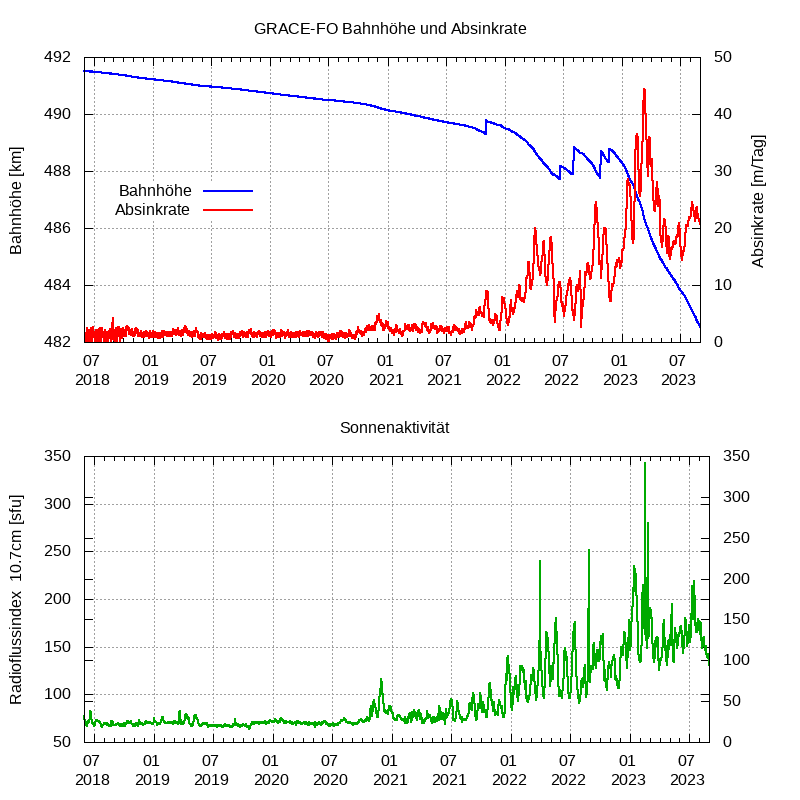The lifetime of GRACE-FO

The lifetime of the two GRACE-FO satellites and their instruments was designed by the manufacturers to be five years, which was reached in May 2023. By then, the mission entered its "bonus phase" already. Minor problems such as the switchover of the Instrument Processing Unit (IPU) on the second satellite GFO-2 to its reserve unit shortly after launch, which was necessary due to technical problems, only disturbed the mission for a brief period of time. Also the accelerometer, which is important for correcting atmospheric drag (at the satellites’ flight altitude) and solar radiation pressure (the so-called "non-gravitational accelerations"), did not meet its specifications on GFO-2. To solve this problem, scientists at JPL developed a procedure in which the data from the first satellite is being "transplanted" to the second spacecraft. As a result, nominal monthly gravity field models are continuously calculated from the measurement data in the Science Data System.
Since boreal summer 2021, the solar activity has been steadily increasing and will reach its maximum around the year 2025. This approximately 11-year cycle causes greater non-gravitational accelerations, an associated faster orbital decay and ultimately higher fuel consumption for the satellites. Scientists are closely monitoring these phenomena and are taking appropriate countermeasures to extend the lifetime of GRACE-FO until at least 2028. This would still be twice as long as originally planned. The first GRACE mission (2002-2016) was also designed to operate for five years, which could eventually be extended to three times of that period.
The follow-up mission GRACE-C
NASA identified the observation of mass transport as one of its top five priorities in its most recent Decadal Survey. To realise the next mission of this kind, NASA seeks again international partners. Thanks to the outstanding technological and scientific cooperation on GRACE and GRACE-FO, the GFZ, the Max Planck Society (MPG) and the DLR, in collaboration with German industry, have already responded to this opportunity and conducted several studies in close collaboration with JPL/NASA. As a result, in September 2022, at the end of Phase A (funded by the BMBF and carried out by the GFZ), a proposal was identified for a follow-up mission based on the Laser Ranging Interferometer (LRI) technology demonstrator as successfully realised on GRACE-FO. In October 2022, the German Bundestag approved the financing of the German funding part for the mission (covering the procurement of the launch vehicle, implementation of mission operations at the German Space Operation Center (GSOC) of DLR and the Science Data System at GFZ, as well as the design and construction of the optical components of the LRI). As with GRACE-FO, NASA will again provide the electronic components of the LRI, the two accelerometers and parts of the scientific data exploitation. The manufacturing of the two satellites will again be carried out by Airbus in Germany on behalf of JPL/NASA. This does not only result in a financial "win-win situation" for Germany, but also greatly limits the technical, financial and scheduling risks by replicating a successfully operated mission concept, this time without the technically obsolete microwave distance measurement and also without IPUs.
GRACE-C mission from GFZ and is currently working with NASA on the concept, the cooperation agreements with the scientific partners GFZ and MPG, and the contracts with the German industry. The construction phase is scheduled to begin in October 2023. The launch of the mission is planned for May 2028, so that the nominally five-year operating period would last until 2033 and could thus, in combination with the existing GRACE and GRACE-FO data records, provide an observation time series covering three decades.
Vision: the double-pair constellation NGGM/MAGIC
The gravity field missions GRACE, GRACE-FO and their future sucessor mission GRACE-I are very well suited to monitor serious consequences of climate change that manifest slowly over long time inverals. These include melting of the polar ice sheets, rising sea-level, or changes in the terrestrial water storage. However, all GRACE single-pair missions had the disadvantage that resolution is limited to one month temporally and 300 km spatially, and are thus relatively inaccurate for many practical applications. Mass transports can also not always be clearly assigned to a specific area, which has to be accounted for in any subsequent data processing.
In order to reduce these disadvantages of the GRACE measurement principle, ESA is planning the so-called Next Generation GravityGravity is also known as the force of gravity or mass attraction. Gravity is the force that two or more bodies exert on each other due to their mass. The best-known gravitational force is the Earth's gravitational pull. It causes bodies on earth to f... Mission (NGGM). This novel mission will orbit the Earth from about 2032 onwards on an inclined path (65-70 degrees inclination to the equator) and a much lower (about 400 km) altitude. Observation of the non-gravitational perturbation forces is to be additionally improved by an accelerometer that is about ten times more accurate than previously flown on GRACE-FO. The combination of two missions into a double-pair constellation will significantly reduce the described disadvantages of a single pair, so that numerous new geophysical application scenarios will be enabled.
Another big advantage will be that the calculation of global gravity fields can be done for just a few instead of 30 days, and post-processing or spatial smoothing would only be necessary in rather exceptional cases. In addition, near-real-time (NRT) mass transport estimates should enable operational services such as the regular monitoring of flood events or droughts.
Text: Prof. Dr. Frank Flechtner, GFZ
Further information
ESA article on the future mission: The future of gravity is MAGIC, 25.04.2023
